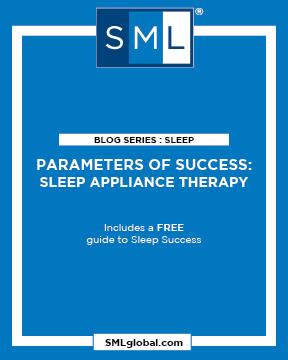 Parameters of Success: Sleep Appliance Therapy
Parameters of Success: Sleep Appliance Therapy
To be successful in deciding upon the right sleep appliance, you need to know:
1. Materials, qualities, design and functional specifics of the different appliances. Hard acrylic? Cad-Cam Appliance? Does it allow lateral movement? Is it easily adjustable for patient and/or doctor? How is it retained – ball clasps and clasps? Is it lined with thermoplastic material? Can you adjust it and realign it easily?
2. What are the controlling parameters in relation to the patient? You will need to perform a full and complete dental sleep examination and a TMJ exam. What are the number of teeth in both arches? Any signs of periodontal disease or decay? Are there…
broken fillings or crowns that need to be replaced? Signs of lateral bruxism? Does the patient open and close comfortably? What is the range of lateral movement? What is the range of movement from centric relation to the most protrusive position. What is the size of their tongue, the size of their arches, the patency of their nasal airway? Look at the tonsils, adenoids, the soft palate, hard palate. Do they have a high vaulted palate? Are they a skeletal class l, ll, or lll? As a dentist we should be looking at all possible levels of obstruction: nasal, oral and hypopharyngeal airway spaces.
Knowing the answers to these questions is of primary importance.
3. The third consideration focuses on a pet peeve of mine. I feel that one of the main reasons that appliances don’t work at a higher success rate overall is that a combined therapy approach, while often needed, is seldom considered.
Even when you choose what you believe to be the best appliance for the patient, even when you have a firm grasp of the patient landscape, even when you cover all the basics and evaluate all the single appliance possibilities, it may not be enough. You still may need to implement a combined therapy approach.
This approach may prove as simple as prescribing a sleep appliance with a nasal strip – to encourage the patient to breath nasally and keep the air passage open. It may be as detailed and in-depth as employing a CPAP with an appliance of choice.
What if your patients nose is completely blocked? Perhaps they have a significantly deviated septum or polyps which are blocking the nasal airway. For a patient like that, the therapy of choice may necessarily include nasal surgery to clear the airway…before adding an appliance.
For more on the range of available sleep appliances for all types of sleep appliance therapy, be sure to access and review our extensive sleep section at: SMLglobal.com.
Or call us at 800-423-3270 to schedule a 30-minute Powerpoint presentation or custom webinar/workshop detailing how our sleep experts and appliances can help you integrate sleep therapy into your growing practice.
To Download a Free Copy of our Guide to Sleep Success PDF, Click Here.




